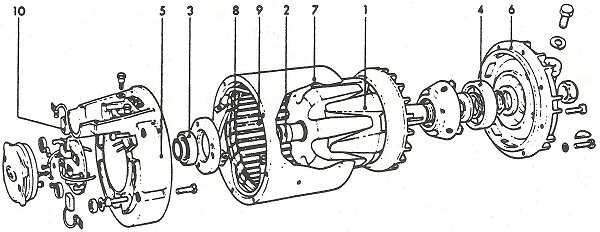Charging Systems
Alternators - An Introduction
from a BR training booklet
The alternator must be considered as an integral part of the complete battery charging system. It is extremely straightforward in construction, consisting basically of a field coil assembly (the rotor) which rotates inside a stationary set of generator windings (the stator).
The magnetic lines of force present around the field coil cut across the coils of the stator windings and generate an alternating current. The frequency and magnitude of this current rise as the speed of the rotor increases.
The rugged construction of the rotor permits very high rotational speeds of up to 10,000 rpm to be obtained. This in turn means that a high engine-to-alternator drive ratio can be used, resulting in a usefully high current output being generated at engine idling speeds.
Mechanical Construction
The figure below shows the construction of a typical CAV 9-diode alternator. The rotor assembly consists of the field coil, slip rings and two soft iron claws all mounted on a common shaft. The fingers of the claws (1) are interposed and form the magnetic poles, the field coil being positioned between them. Each lead from the field coil is connected to one of the two slip rings (2).
The complete rotor assembly is carried on two heavy duty ball or roller bearings (3 & 4) mounted in the slip ring and drive end shields (5 & 6). These end shields are firmly secured one to each end of the stator (7), the whole assembly forming a very rigid structure.
The three phase stator windings (8) are secured in the slotted stator laminations (9) which are themselves contained within the aluminium alloy stator.
Because the slip rings are sealed in and have to carry only light currents - in the order of 3 amperes or less - the brushes (1) can be quite small and light in weight. Consequently, brush and slip ring wear is negligible and the time periods between overhauls greatly increased.

Dynamos (Generators)
Maintenance in preservation
Unmodified regulator settings
Modified regulator settings
Fault Finding and Maintenance
Stone's Leaflets:
A1002 - The Lamp Resistance
D1001 - Train Lighting Introduction
D1009 - Control Panel Description
E1016 - Panel, Enclosure - Open
E1018 - Panel, Totally Enclosed
P1002 - "Liliput" Regulator
P1006 - Tonum Control Panel
W1009 - Control Panel Diagrams
Alternators
Maintenance in preservation
In Introduction to Alternators
AC8 - Operation
AC8 - Maintenance & Fault Finding
AC8 - CAV Manual
AC8 - CAV Spares Parts List
AC8 - Schematic Diagram
AC14 - Schematic Diagram
AC203 - Description
AC203 - Operation
AC203 - Maintenance & Fault Finding
AC203 - Fault Finding - alternate
AC203 - CEPS 179 Overhaul Manual
CAV Rectifiers - Spare Parts
CAV460 Control Board
The Fast Fuse
FAQs on alternators


